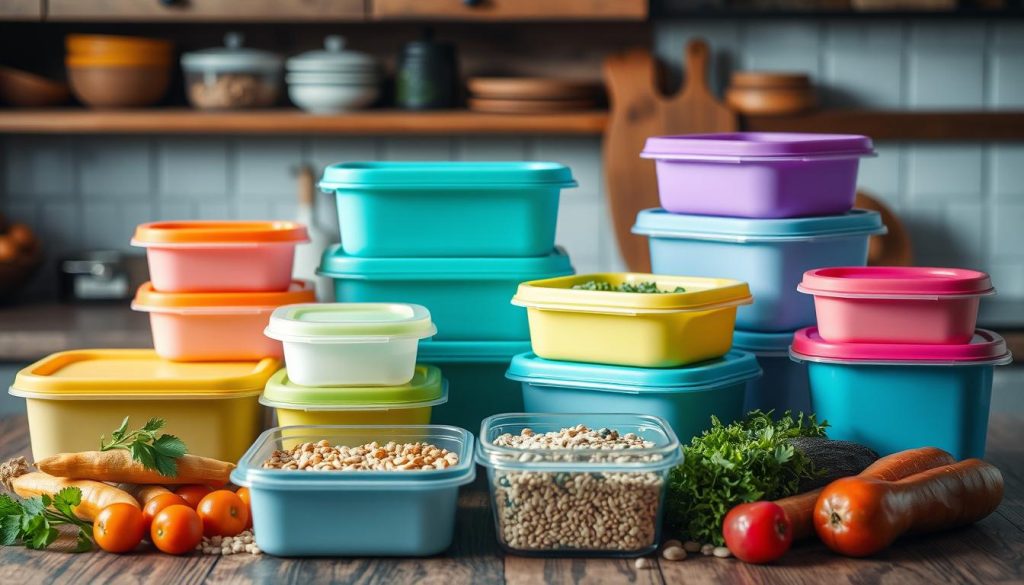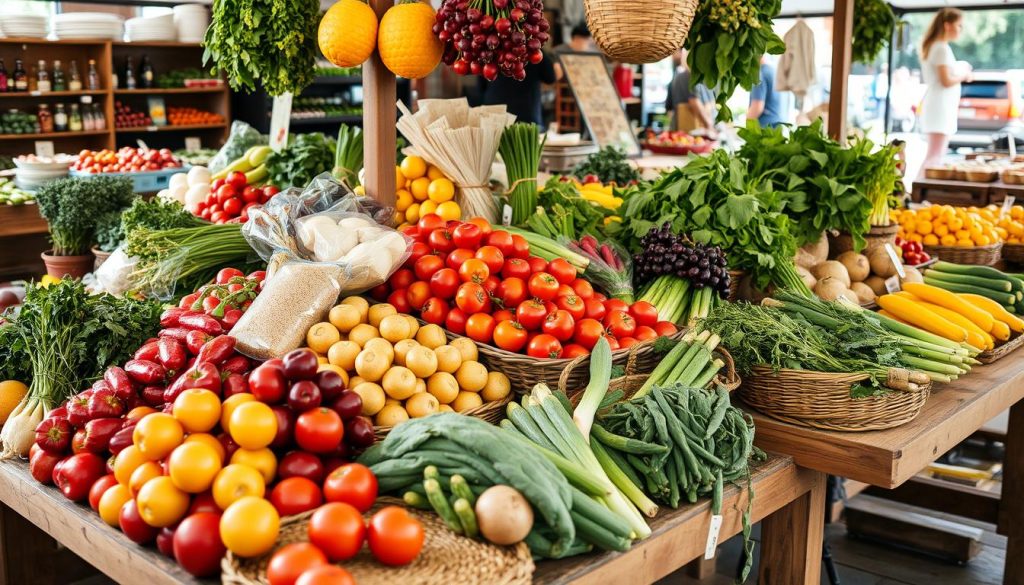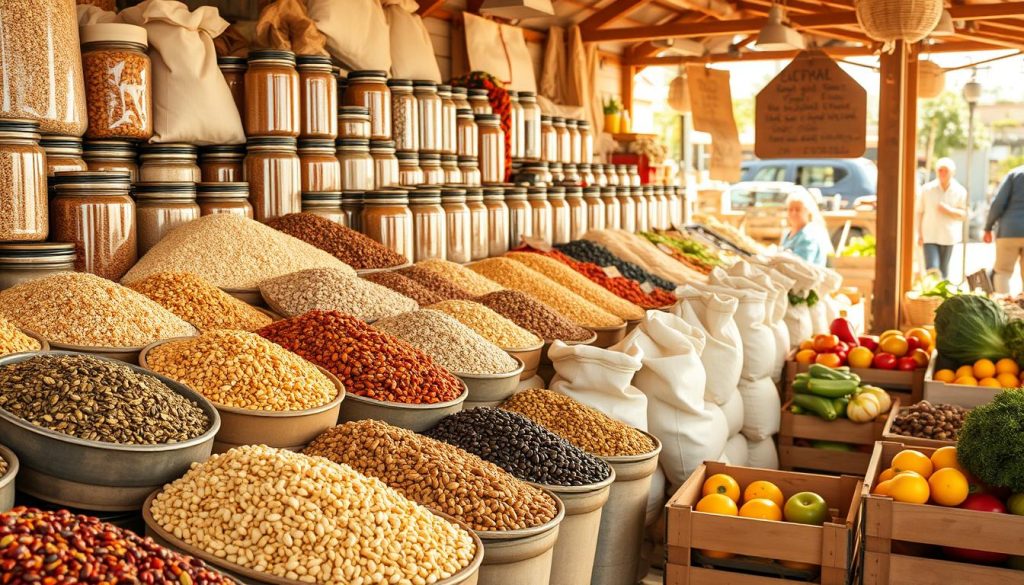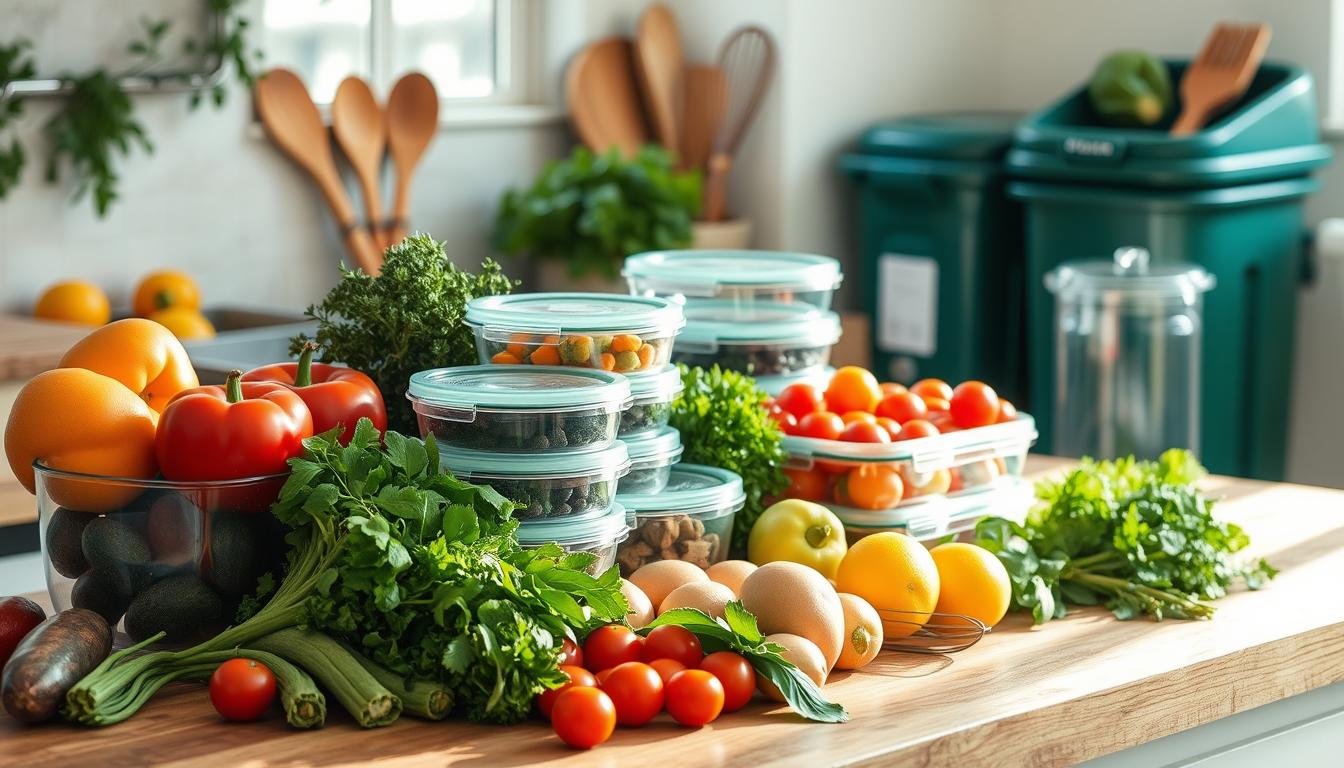I’ve been working to cut down on food waste and cook in a way that’s good for the planet. I’m excited to share how to do zero waste meal prep. It’s a big step towards reducing our environmental footprint, saving money, and getting healthier.
In today’s fast world, it’s easy to waste food without thinking about it. But, food waste is a big problem that harms our planet and uses up resources. By choosing zero waste meal prep, we can fight this issue and make a difference.
In the next pages, I’ll show you how to start zero waste cooking. We’ll look at the main ideas behind it, its benefits for the environment, and how to make it part of your life. You’ll learn how to plan meals, use leftovers, and make food that’s good for you and the planet.
What is Zero Waste Meal Prep?
Zero waste meal prep is a way to cook and prepare food that’s good for the planet. It’s about using every bit of what you buy and planning meals carefully. It also means finding new uses for leftovers.
Understanding the Concept of Zero Waste
The zero waste idea makes us think differently about how we use things. In meal prep, it means choosing ingredients wisely and avoiding extra packaging. It’s about using all parts of the food we buy.
Why It Matters for the Environment
Food waste harms the environment a lot. When food rots in landfills, it releases methane, a bad gas for the planet. Also, growing, processing, and storing food that’s thrown away wastes a lot of resources.
By choosing zero waste meal prep, we can cut down on food waste. This saves natural resources and reduces our impact on the environment. It’s good for the planet and can also save us money and help us eat healthier.
Benefits of Zero Waste Meal Prep
Choosing a minimalist meal prep way and using plant-based foods can greatly improve your life. It helps you save money and supports a greener future. Plus, it makes your eating habits healthier.
Reducing Food Waste and Saving Money
Zero waste meal prep cuts down on food waste a lot. By planning meals carefully and using all ingredients, you throw away less food. This saves money and helps the planet.
Healthier Eating Habits
Going for a minimalist, plant-based meal prep way helps you eat better. You focus on whole, unprocessed foods. This means your body gets the nutrients it needs, boosting your health and energy.
Adopting minimalist and plant-based meal prep changes your life for the better. It’s good for the planet, your wallet, and your health. It’s a smart, sustainable way to cook.
Essential Tools for Zero Waste Meal Prep

Living a zero waste life isn’t just about what we eat. It’s also about the tools we use in the kitchen. The right reusable containers and eco-friendly gadgets help cut down on single-use plastic. They support a greener way to cook.
Reusable Containers and Bags
For zero waste meal prep, you need durable containers. Choose glass, stainless steel, or BPA-free plastic ones. They should last a long time. Also, get reusable storage bags to replace disposable ones for storing food or ingredients.
Eco-Friendly Kitchen Gadgets
There are also eco-friendly kitchen tools to consider. Look for silicone baking mats, bamboo utensils, and compostable bags. These items help reduce your use of single-use plastics. Small changes can make a big difference in kitchen waste.
Using these tools for zero waste meal prep helps the environment. It also makes your kitchen more organized and convenient.
Tips for Meal Planning with Zero Waste

Adopting sustainable cooking and eco-friendly meal planning can greatly reduce food waste and save money. Effective meal planning is a crucial part of this approach. Here are some practical tips to help you achieve zero waste meal prep.
Creating a Flexible Meal Schedule
Meal plans that are too rigid can lead to food spoilage and waste. Instead, create a flexible schedule. This allows you to adapt to changing needs and use what you have on hand. Be open to spontaneity and using what’s in your pantry or fridge.
Incorporating Seasonal and Local Ingredients
Using seasonal and locally-sourced ingredients in your meal planning reduces environmental impact. It also ensures your food is fresh and flavorful. Take advantage of what’s in season and try new recipes that highlight the season’s best produce.
Here are some strategies for planning eco-friendly meals:
- Check your local farmers market or community-supported agriculture (CSA) program to discover seasonal, locally-grown options.
- Adjust your meal plan based on what’s in season, ensuring you use ingredients at their peak freshness.
- Explore recipes that allow you to use the entire vegetable or fruit, reducing food waste.
By adopting a flexible, seasonal approach to meal planning, you’ll reduce waste. You’ll also enjoy the bold flavors and nutritional benefits of sustainable cooking.
Zero Waste Grocery Shopping Strategies

Starting a zero waste lifestyle begins with grocery shopping. Making smart choices can lessen our environmental footprint and support green food systems. Let’s look at some easy ways to make your shopping trips greener.
Making a Realistic Shopping List
Before you go to the store, plan your meals and make a detailed shopping list. This reduces food waste and ensures you buy only what you need. Try to buy items in bulk or without packaging to lessen packaging waste.
Choosing Bulk and Package-Free Options
- Look for local stores, co-ops, or specialty shops with bulk bins for grains, legumes, nuts, spices, and more. Use your own reusable containers to fill up.
- Choose fresh produce, meat, and dairy without packaging. Visit farmers’ markets or zero waste stores for the exact amount you need.
- Use alternatives to single-use plastics like beeswax wraps, silicone bags, and reusable produce bags for your plastic-free meal prep.
By making these changes, you can greatly reduce waste from your shopping trips. Every small step towards zero waste counts a lot in the long run.
Creative Ways to Use Leftovers
Reducing food waste is key to sustainable cooking. By using leftovers, we can cut down on waste and make tasty new dishes. Let’s look at some creative ways to turn leftovers into fresh meals.
Transforming Leftovers into New Meals
Leftovers don’t have to be dull. A bit of creativity can make them exciting again. For example, leftover roasted veggies can become a tasty stir-fry or a rich soup. Cooked grains like rice or quinoa can be turned into crispy fritters or savory croquettes.
Recipes That Minimize Waste
Using every part of an ingredient is crucial for reducing waste. This means using the whole vegetable, including stems and leaves. Carrot tops can make a vibrant pesto, and broccoli stalks are great in stir-fries or salads.
Plan meals that use up common leftovers, like overripe bananas or wilted greens. Banana bread, smoothies, and vegetable frittatas are all good options. They help you use up what you have and reduce waste.
By being creative with leftovers, you can lower your environmental impact. It also helps you discover new recipes and improve your cooking skills. Sustainable cooking is about making the most of what you have and finding ways to reduce waste.
My Journey Towards Zero Waste Meal Prep
Starting a zero waste lifestyle was a slow but fulfilling journey for me. At first, the goal of cutting down food waste seemed huge. But I was set on making a difference for our planet. Changing my shopping and meal planning habits was a big hurdle.
Challenges I Faced and How I Overcame Them
Switching to waste-free meal prep changed how I shopped. I had to plan better and avoid buying things on impulse. Composting was a breakthrough, turning food scraps into garden soil. It took some effort to learn, but now it’s easy.
My Favorite Recipes and Tips for Beginners
I love making a vegetable stir-fry with fridge leftovers. Homemade broths and stocks from veggie scraps and chicken bones are also favorites. For newbies, start small by using reusable bags and using all parts of food. Composting is also a great way to cut down waste and feed your garden.

